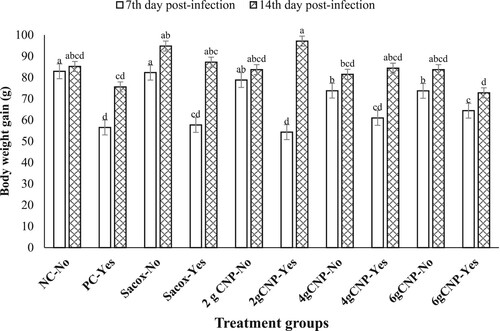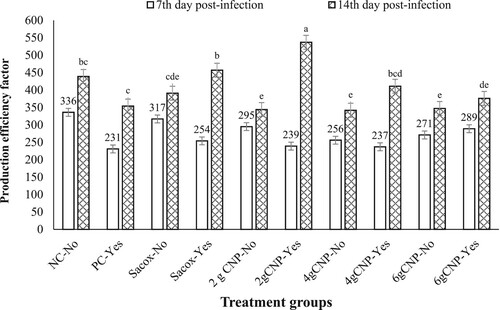Figures & data
Table 1. Ingredients and calculated nutrients of broilers diet.
Table 2. Serum biochemical parameters of Eimeria tenella-infected and uninfected broiler chickens fed diets containing varying levels of Cinnamomum verum bark powder at 27 days of age (at 7 days post inoculation).
Table 3. Leukogram of blood samples collected at 27 days of age from Eimeria tenella-infected and uninfected broiler chickens fed experimental diets.
Table 4. Cecal lesion score (0-4) and faecal oocyst output (Log10 per g excreta) (at 7 days post infection) from Eimeria tenella-infected and uninfected broiler chickens fed experimental diets.
Table 5. Relative carcasses weights of Eimeria tenella-infected and uninfected broiler chickens fed diets containing varying levels of Cinnamomum verum bark powder at 27 days of age (at 7 days post inoculation).
Table 6. Total and partial lengths and weights of the small intestine and intestinal relative weight of Eimeria tenella-infected and uninfected broiler chickens fed diets containing varying levels of Cinnamomum verum bark powder at 27 days of age (at 7 days post inoculation) (% of small intestine).
Figure 1. The effect of dietary treatments and coccidial challenge on body weight gain of broiler chickens at 7th and 14th days post-infection. a-dDifferent superscript letters indicate statistical significant differences (P < 0.05) between groups.

Figure 2. The effect of dietary treatments and coccidial challenge on production efficiency factor of broiler chickens at 7th and 14th days post-infection. a-eDifferent superscript letters indicate statistical significant differences between groups (P < 0.05).

Table 7. Daily weight gain (DWG), daily feed intake (DFI), feed conversion ratio (FCR) and production efficiency factor (PEF) of Eimeria tenella-infected and uninfected broiler chickens fed diets containing varying levels of Cinnamomum verum bark powder at 27 and 34 days of age (at 7 and 14 days post inoculation ‘dpi’).
